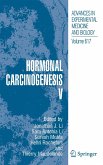Hiroshi Maruta (ed.)
Tumor Suppressing Viruses, Genes, and Drugs
Innovative Cancer Therapy Approaches
Mitarbeit:Maruta, Hiroshi
Hiroshi Maruta (ed.)
Tumor Suppressing Viruses, Genes, and Drugs
Innovative Cancer Therapy Approaches
Mitarbeit:Maruta, Hiroshi
- Gebundenes Buch
- Merkliste
- Auf die Merkliste
- Bewerten Bewerten
- Teilen
- Produkt teilen
- Produkterinnerung
- Produkterinnerung
Tumor Suppressing Viruses, Genes, and Drugs profiles the new generation of cancer treatments now in development. The book examines the innovative new approaches of viral, gene, and signal therapies that promise to replace or enhance conventional methods such as surgery, radiation, and chemotherapy. The timely information presented by this book should be of interest to anyone concerned with advancing cancer treatment beyond current medical practices.
Andere Kunden interessierten sich auch für
![Advances in Cancer Research Advances in Cancer Research]() Advances in Cancer Research13,99 €
Advances in Cancer Research13,99 €![Marek's Disease Marek's Disease]() Fred Davison / Venugopal Nair (eds.)Marek's Disease160,99 €
Fred Davison / Venugopal Nair (eds.)Marek's Disease160,99 €![Hot Topics in Infection and Immunity in Children V Hot Topics in Infection and Immunity in Children V]() Hot Topics in Infection and Immunity in Children V110,99 €
Hot Topics in Infection and Immunity in Children V110,99 €![Detection of Bacteria, Viruses, Parasites and Fungi Detection of Bacteria, Viruses, Parasites and Fungi]() Detection of Bacteria, Viruses, Parasites and Fungi245,99 €
Detection of Bacteria, Viruses, Parasites and Fungi245,99 €![Hormonal Carcinogenesis V Hormonal Carcinogenesis V]() Jonathan J. Li (ed.)Hormonal Carcinogenesis V148,99 €
Jonathan J. Li (ed.)Hormonal Carcinogenesis V148,99 €![Detection of Bacteria, Viruses, Parasites and Fungi Detection of Bacteria, Viruses, Parasites and Fungi]() Mariapia Viola Magni (Hrsg.)Detection of Bacteria, Viruses, Parasites and Fungi147,99 €
Mariapia Viola Magni (Hrsg.)Detection of Bacteria, Viruses, Parasites and Fungi147,99 €![New Concepts of Antiviral Therapy New Concepts of Antiviral Therapy]() Elke Bogner / Andreas Holzenburg (eds.)New Concepts of Antiviral Therapy125,99 €
Elke Bogner / Andreas Holzenburg (eds.)New Concepts of Antiviral Therapy125,99 €-
-
-
Tumor Suppressing Viruses, Genes, and Drugs profiles the new generation of cancer treatments now in development. The book examines the innovative new approaches of viral, gene, and signal therapies that promise to replace or enhance conventional methods such as surgery, radiation, and chemotherapy. The timely information presented by this book should be of interest to anyone concerned with advancing cancer treatment beyond current medical practices.
Hinweis: Dieser Artikel kann nur an eine deutsche Lieferadresse ausgeliefert werden.
Hinweis: Dieser Artikel kann nur an eine deutsche Lieferadresse ausgeliefert werden.
Produktdetails
- Produktdetails
- Verlag: Academic Press
- Artikelnr. des Verlages: B978-0-12-476249-7.X5000-0
- Seitenzahl: 425
- Erscheinungstermin: 18. Oktober 2001
- Englisch
- Abmessung: 235mm x 160mm x 23mm
- Gewicht: 811g
- ISBN-13: 9780124762497
- ISBN-10: 0124762492
- Artikelnr.: 10181965
- Herstellerkennzeichnung
- Produktsicherheitsverantwortliche/r
- Europaallee 1
- 36244 Bad Hersfeld
- gpsr@libri.de
- Verlag: Academic Press
- Artikelnr. des Verlages: B978-0-12-476249-7.X5000-0
- Seitenzahl: 425
- Erscheinungstermin: 18. Oktober 2001
- Englisch
- Abmessung: 235mm x 160mm x 23mm
- Gewicht: 811g
- ISBN-13: 9780124762497
- ISBN-10: 0124762492
- Artikelnr.: 10181965
- Herstellerkennzeichnung
- Produktsicherheitsverantwortliche/r
- Europaallee 1
- 36244 Bad Hersfeld
- gpsr@libri.de
Contributors
Preface
1 Oncolytic Viruses: Virotherapy for Cancer
I. Introduction
II. Attributes of Replication-Selective Viruses for Cancer Treatment
III. Approaches to Optimizing Tumor-Selective Viral Replication
IV. Adenoviruses
V. Poliovirus
VI. Vesicular Stomatitis Virus
VII. Reovirus
VIII. Bacteria
IX. Vaccinia Virus
X. Herpesvirus
XI. Clinical Trial Results with Replication-Competent Adenoviruses in Cancer Patients
XII. Results from Clinical Trials with dl1520 (Onyx-015, or CI-1042)
XIII. Future Directions: Approaches to Improving the Efficacy of Replication-Selective Viral Agents
XIV. Summary
References
2 Reovirus Therapy of Ras-Associated Cancers
I. Introduction
II. Reovirus Oncolysis
III. Concluding Remarks
References
3 Oncolytic Herpes Simplex Virus (G207) Therapy: From Basic to Clinical
I. Introduction
II. Preclinical Studies of G207
III. G207 Clinical Trial
IV. Conclusions
References
4 p53 and Its Targets
I. Introduction
II. Activation of p53
III. Downstream Mediators of p53
References
5 Prospects for Tumor Suppressor Gene Therapy: RB as an Example
I. Introduction
II. Functions of RB
III. Successes with RB Gene Therapy
IV. Perspectives
References
6 CDK Inhibitors: Genes and Drugs
I. Introduction
II. G1 Regulation
III. p16INK4a and the Rb Pathway
IV. p19ARF and p53 Pathway
V. p27 and Human Cancer
VI. Conclusions and Future Perspectives
References
7 CDK Inhibitors: Small Molecular Weight Compounds
I. Introduction
II. Cyclin-Dependent Kinases, the Cell Cycle, and Cancer
III. Cyclin-Dependent Kinase Inhibitors, a Large Variety of Structures
IV. Cyclin-Dependent Kinase Inhibitors, All Competing with ATP
V. Cyclin-Dependent Kinase Inhibitors, the Selectivity Problem
VI. Cyclin-Dependent Kinase Inhibitors, Cellular Effects
VII. Cyclin-Dependent Kinase Inhibitors, Antitumor Activity
VIII. Conclusion
References
8 NF1 and Other RAS-Binding Peptides
I. RAS Molecules: Normal versus Oncogenic Mutants
II. Super GAP?
III. RAS-Binding Fragment of NF1
IV. c-RAF-1
V. PI-3 Kinase
VI. Ral GDS
References
9 Cytoskeletal Tumor Suppressor Genes
I. Introduction (Historical Background)
II. Type I Cytoskeletal Tumor Suppressors
III. Type II Cytoskeletal Tumor Suppressors
References
10 TGF-? Signaling and Carcinogenesis
I. Introduction
II. Dual Role of TGF-? in Carcinogenesis
III. TGF-? Superfamily Signaling
IV. Perturbation of TGF-? Signaling in Cancer Cells
V. Perspectives
References
11 DAN Gene
I. Introduction
II. Cloning of DAN cDNA
III. Transfection of DAN
IV. Role of DAN in Neuroblastomas
V. Structural Features of the DAN Protein
VI. Genomic Structure of DAN
VII. DAN Family
References
12 Design of Hammerhead Ribozymes and Allosterically Controllable Maxizymes for Cancer Gene Therapy
I. Introduction
II. Ribozyme Expression System in Cells
III. Design of the tRNAVal-Driven Ribozyme That Is Transcribed by pol III
IV. Design of Allosterical
Preface
1 Oncolytic Viruses: Virotherapy for Cancer
I. Introduction
II. Attributes of Replication-Selective Viruses for Cancer Treatment
III. Approaches to Optimizing Tumor-Selective Viral Replication
IV. Adenoviruses
V. Poliovirus
VI. Vesicular Stomatitis Virus
VII. Reovirus
VIII. Bacteria
IX. Vaccinia Virus
X. Herpesvirus
XI. Clinical Trial Results with Replication-Competent Adenoviruses in Cancer Patients
XII. Results from Clinical Trials with dl1520 (Onyx-015, or CI-1042)
XIII. Future Directions: Approaches to Improving the Efficacy of Replication-Selective Viral Agents
XIV. Summary
References
2 Reovirus Therapy of Ras-Associated Cancers
I. Introduction
II. Reovirus Oncolysis
III. Concluding Remarks
References
3 Oncolytic Herpes Simplex Virus (G207) Therapy: From Basic to Clinical
I. Introduction
II. Preclinical Studies of G207
III. G207 Clinical Trial
IV. Conclusions
References
4 p53 and Its Targets
I. Introduction
II. Activation of p53
III. Downstream Mediators of p53
References
5 Prospects for Tumor Suppressor Gene Therapy: RB as an Example
I. Introduction
II. Functions of RB
III. Successes with RB Gene Therapy
IV. Perspectives
References
6 CDK Inhibitors: Genes and Drugs
I. Introduction
II. G1 Regulation
III. p16INK4a and the Rb Pathway
IV. p19ARF and p53 Pathway
V. p27 and Human Cancer
VI. Conclusions and Future Perspectives
References
7 CDK Inhibitors: Small Molecular Weight Compounds
I. Introduction
II. Cyclin-Dependent Kinases, the Cell Cycle, and Cancer
III. Cyclin-Dependent Kinase Inhibitors, a Large Variety of Structures
IV. Cyclin-Dependent Kinase Inhibitors, All Competing with ATP
V. Cyclin-Dependent Kinase Inhibitors, the Selectivity Problem
VI. Cyclin-Dependent Kinase Inhibitors, Cellular Effects
VII. Cyclin-Dependent Kinase Inhibitors, Antitumor Activity
VIII. Conclusion
References
8 NF1 and Other RAS-Binding Peptides
I. RAS Molecules: Normal versus Oncogenic Mutants
II. Super GAP?
III. RAS-Binding Fragment of NF1
IV. c-RAF-1
V. PI-3 Kinase
VI. Ral GDS
References
9 Cytoskeletal Tumor Suppressor Genes
I. Introduction (Historical Background)
II. Type I Cytoskeletal Tumor Suppressors
III. Type II Cytoskeletal Tumor Suppressors
References
10 TGF-? Signaling and Carcinogenesis
I. Introduction
II. Dual Role of TGF-? in Carcinogenesis
III. TGF-? Superfamily Signaling
IV. Perturbation of TGF-? Signaling in Cancer Cells
V. Perspectives
References
11 DAN Gene
I. Introduction
II. Cloning of DAN cDNA
III. Transfection of DAN
IV. Role of DAN in Neuroblastomas
V. Structural Features of the DAN Protein
VI. Genomic Structure of DAN
VII. DAN Family
References
12 Design of Hammerhead Ribozymes and Allosterically Controllable Maxizymes for Cancer Gene Therapy
I. Introduction
II. Ribozyme Expression System in Cells
III. Design of the tRNAVal-Driven Ribozyme That Is Transcribed by pol III
IV. Design of Allosterical
Contributors
Preface
1 Oncolytic Viruses: Virotherapy for Cancer
I. Introduction
II. Attributes of Replication-Selective Viruses for Cancer Treatment
III. Approaches to Optimizing Tumor-Selective Viral Replication
IV. Adenoviruses
V. Poliovirus
VI. Vesicular Stomatitis Virus
VII. Reovirus
VIII. Bacteria
IX. Vaccinia Virus
X. Herpesvirus
XI. Clinical Trial Results with Replication-Competent Adenoviruses in Cancer Patients
XII. Results from Clinical Trials with dl1520 (Onyx-015, or CI-1042)
XIII. Future Directions: Approaches to Improving the Efficacy of Replication-Selective Viral Agents
XIV. Summary
References
2 Reovirus Therapy of Ras-Associated Cancers
I. Introduction
II. Reovirus Oncolysis
III. Concluding Remarks
References
3 Oncolytic Herpes Simplex Virus (G207) Therapy: From Basic to Clinical
I. Introduction
II. Preclinical Studies of G207
III. G207 Clinical Trial
IV. Conclusions
References
4 p53 and Its Targets
I. Introduction
II. Activation of p53
III. Downstream Mediators of p53
References
5 Prospects for Tumor Suppressor Gene Therapy: RB as an Example
I. Introduction
II. Functions of RB
III. Successes with RB Gene Therapy
IV. Perspectives
References
6 CDK Inhibitors: Genes and Drugs
I. Introduction
II. G1 Regulation
III. p16INK4a and the Rb Pathway
IV. p19ARF and p53 Pathway
V. p27 and Human Cancer
VI. Conclusions and Future Perspectives
References
7 CDK Inhibitors: Small Molecular Weight Compounds
I. Introduction
II. Cyclin-Dependent Kinases, the Cell Cycle, and Cancer
III. Cyclin-Dependent Kinase Inhibitors, a Large Variety of Structures
IV. Cyclin-Dependent Kinase Inhibitors, All Competing with ATP
V. Cyclin-Dependent Kinase Inhibitors, the Selectivity Problem
VI. Cyclin-Dependent Kinase Inhibitors, Cellular Effects
VII. Cyclin-Dependent Kinase Inhibitors, Antitumor Activity
VIII. Conclusion
References
8 NF1 and Other RAS-Binding Peptides
I. RAS Molecules: Normal versus Oncogenic Mutants
II. Super GAP?
III. RAS-Binding Fragment of NF1
IV. c-RAF-1
V. PI-3 Kinase
VI. Ral GDS
References
9 Cytoskeletal Tumor Suppressor Genes
I. Introduction (Historical Background)
II. Type I Cytoskeletal Tumor Suppressors
III. Type II Cytoskeletal Tumor Suppressors
References
10 TGF-? Signaling and Carcinogenesis
I. Introduction
II. Dual Role of TGF-? in Carcinogenesis
III. TGF-? Superfamily Signaling
IV. Perturbation of TGF-? Signaling in Cancer Cells
V. Perspectives
References
11 DAN Gene
I. Introduction
II. Cloning of DAN cDNA
III. Transfection of DAN
IV. Role of DAN in Neuroblastomas
V. Structural Features of the DAN Protein
VI. Genomic Structure of DAN
VII. DAN Family
References
12 Design of Hammerhead Ribozymes and Allosterically Controllable Maxizymes for Cancer Gene Therapy
I. Introduction
II. Ribozyme Expression System in Cells
III. Design of the tRNAVal-Driven Ribozyme That Is Transcribed by pol III
IV. Design of Allosterical
Preface
1 Oncolytic Viruses: Virotherapy for Cancer
I. Introduction
II. Attributes of Replication-Selective Viruses for Cancer Treatment
III. Approaches to Optimizing Tumor-Selective Viral Replication
IV. Adenoviruses
V. Poliovirus
VI. Vesicular Stomatitis Virus
VII. Reovirus
VIII. Bacteria
IX. Vaccinia Virus
X. Herpesvirus
XI. Clinical Trial Results with Replication-Competent Adenoviruses in Cancer Patients
XII. Results from Clinical Trials with dl1520 (Onyx-015, or CI-1042)
XIII. Future Directions: Approaches to Improving the Efficacy of Replication-Selective Viral Agents
XIV. Summary
References
2 Reovirus Therapy of Ras-Associated Cancers
I. Introduction
II. Reovirus Oncolysis
III. Concluding Remarks
References
3 Oncolytic Herpes Simplex Virus (G207) Therapy: From Basic to Clinical
I. Introduction
II. Preclinical Studies of G207
III. G207 Clinical Trial
IV. Conclusions
References
4 p53 and Its Targets
I. Introduction
II. Activation of p53
III. Downstream Mediators of p53
References
5 Prospects for Tumor Suppressor Gene Therapy: RB as an Example
I. Introduction
II. Functions of RB
III. Successes with RB Gene Therapy
IV. Perspectives
References
6 CDK Inhibitors: Genes and Drugs
I. Introduction
II. G1 Regulation
III. p16INK4a and the Rb Pathway
IV. p19ARF and p53 Pathway
V. p27 and Human Cancer
VI. Conclusions and Future Perspectives
References
7 CDK Inhibitors: Small Molecular Weight Compounds
I. Introduction
II. Cyclin-Dependent Kinases, the Cell Cycle, and Cancer
III. Cyclin-Dependent Kinase Inhibitors, a Large Variety of Structures
IV. Cyclin-Dependent Kinase Inhibitors, All Competing with ATP
V. Cyclin-Dependent Kinase Inhibitors, the Selectivity Problem
VI. Cyclin-Dependent Kinase Inhibitors, Cellular Effects
VII. Cyclin-Dependent Kinase Inhibitors, Antitumor Activity
VIII. Conclusion
References
8 NF1 and Other RAS-Binding Peptides
I. RAS Molecules: Normal versus Oncogenic Mutants
II. Super GAP?
III. RAS-Binding Fragment of NF1
IV. c-RAF-1
V. PI-3 Kinase
VI. Ral GDS
References
9 Cytoskeletal Tumor Suppressor Genes
I. Introduction (Historical Background)
II. Type I Cytoskeletal Tumor Suppressors
III. Type II Cytoskeletal Tumor Suppressors
References
10 TGF-? Signaling and Carcinogenesis
I. Introduction
II. Dual Role of TGF-? in Carcinogenesis
III. TGF-? Superfamily Signaling
IV. Perturbation of TGF-? Signaling in Cancer Cells
V. Perspectives
References
11 DAN Gene
I. Introduction
II. Cloning of DAN cDNA
III. Transfection of DAN
IV. Role of DAN in Neuroblastomas
V. Structural Features of the DAN Protein
VI. Genomic Structure of DAN
VII. DAN Family
References
12 Design of Hammerhead Ribozymes and Allosterically Controllable Maxizymes for Cancer Gene Therapy
I. Introduction
II. Ribozyme Expression System in Cells
III. Design of the tRNAVal-Driven Ribozyme That Is Transcribed by pol III
IV. Design of Allosterical








